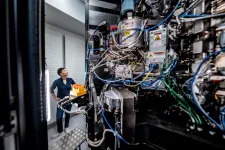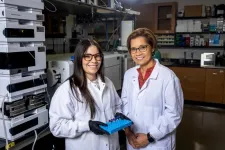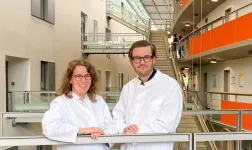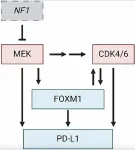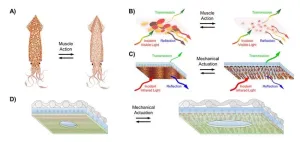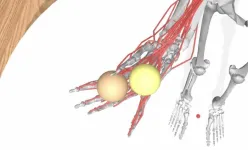(Press-News.org) (MEMPHIS, Tenn. – October 1, 2024) A revolution in biomedicine is currently underway, driven by the application of genome engineering tools such as the prokaryotic CRISPR-Cas9. New genome editing systems continue to be identified in different organisms, adding to the potential toolbox for various therapeutic applications. Scientists at St. Jude Children’s Research Hospital studied the evolutionary journey of Fanzors, eukaryotic genome-editing proteins. Using cryo-electron microscopy (cryo-EM), the researchers provided insights into the structural divergence of Fanzor2 from other RNA-guided nucleases, proposing a framework for future protein engineering endeavors. The findings were published today in Nature Structural & Molecular Biology.
CRISPR-Cas9, the genome-editing approach that won the Nobel Prize in Chemistry in 2020, was adapted from a naturally occurring genome editing system bacteria use as a defense mechanism. CRISPR-Cas systems may have originated from transposons, DNA elements that move from one genomic location to another. Recently, a large and ancient transposon-associated protein family found in bacteria, called TnpB, was discovered to be a functional predecessor to multiple CRISPR-Cas9 and -Cas12 subtypes, providing an evolutionary bridge between the two processes. The Fanzor protein family, comprised of Fanzor1 and Fanzor2, are homologs of TnpB found in eukaryotes and eukaryotic viruses.
Elizabeth Kellogg, PhD, St. Jude Department of Structural Biology, studied the structure of Fanzor2 to chart how these systems have evolved, offering key insights to inform future approaches to genome engineering technology.
Fanzor potential lies in its structure-function relationship
“Since it was discovered that TnpBs are also RNA-guided nucleases, much like CRISPR-Cas9, we’ve become very interested in their diversity,” explained Kellogg. “They have a huge variety in terms of their architecture, shapes and the RNAs that are associated with them. We are just now uncovering all sorts of biological roles for TnpBs.”
One key factor that makes TnpBs and Fanzors so exciting is their relative size — they are significantly smaller than their Cas9 and Cas12 relations. In terms of genome engineering, minimizing the size of the protein offers more functionality. Through cryo-EM structures of Fanzor2 associating with its native RNA guide and DNA target, Kellogg pieced together the relationship between structure and function in RNA-guided nucleases. The work also revealed that RNA’s role in helping to structure the active site of Fanzor2 differs from other classes, suggesting the RNA and protein co-evolved on a separate evolutionary branch from the Cas12 family of CRISPR nucleases.
“The protein was pretty minimal, but the structure suggests there’s way more malleability in terms of how they function with their RNAs,” Kellogg said. “It hints that we could reduce its size further, but there’s a lot more to be done to understand that.”
Kellogg hopes this structure will be the launchpad for novel approaches to engineering the next generation of RNA-guided nucleases. Moreover, considering the diversity of the family, it is clear that with knowledge comes power. “The structural diversity of these complexes is just something that we have no understanding of at all,” she emphasized. “That’s where I think it’s important, not only for understanding the functional constraints that make something an RNA-guided nuclease, but also how you understand those principles and harness them in engineering. That’s what I’m interested in.”
Authors and funding
The study’s first authors are Richard Schargel, Cornell University; and Zuhaib Qayyum and Ajay Singh Tanwar, St. Jude. The study’s other author is Ravi Kalathur, St. Jude.
The study was supported by grants from the National Institutes of Health (R01GM144566), Pew Biomedical Foundation, the National Science Foundation Graduate Research Fellowship Program and ALSAC, the fundraising and awareness organization of St. Jude.
END
Structure of a eukaryotic CRISPR-Cas homolog, Fanzor2, shows its promise for gene editing
2024-10-01
ELSE PRESS RELEASES FROM THIS DATE:
St. Jude names M. Madan Babu, PhD, senior vice president and chief data scientist
2024-10-01
St. Jude Children’s Research Hospital today announced M. Madan Babu, PhD, FRS, as the institution’s first Chief Data Scientist, Senior Vice President for Data Science, and leader of the newly formed Office of Data Science. This $195 million research enterprise will have 115 new positions.
In his new role, Babu will bring new, advanced computing technologies and data science approaches to biomedical research. His team will also facilitate the integration of biological and biomedical ...
It all adds up: Study finds forever chemicals are more toxic as mixtures
2024-10-01
BUFFALO, N.Y. — A first-of-its-kind study has measured the toxicity of several types of per- and polyfluoroalkyl substances (PFAS), better known as “forever chemicals,” when mixed together in the environment and in the human body.
The good news: Most of the tested chemicals’ individual cytotoxicity and neurotoxicity levels were relatively low.
The bad news: the chemicals acted together to make the entire mixture toxic.
“Though they are structurally similar, not all forever chemicals are ...
SwRI-led team discovers carbon dioxide and hydrogen peroxide on Pluto’s moon Charon
2024-10-01
SAN ANTONIO — October 1, 2024 — A Southwest Research Institute-led team has detected carbon dioxide and hydrogen peroxide for the first time on the frozen surface of Pluto’s largest moon, Charon, using observations from the James Webb Space Telescope. These discoveries add to Charon’s known chemical inventory, previously identified by ground- and space-based observations, that includes water ice, ammonia-bearing species and the organic materials responsible for Charon’s gray and red coloration.
“Charon is the only midsized Kuiper Belt object, in the range of 300 to 1,000 miles in diameter, that has been geologically mapped, thanks ...
More clarity on hereditary colorectal cancer
2024-10-01
The genetic confirmation of a suspected diagnosis of "hereditary colorectal cancer" is of great importance for the medical care of affected families. However, many of the variants identified in the known genes cannot yet be reliably classified in terms of their causal role in tumor formation. Under the leadership of the University Hospital Bonn (UKB) and the University of Bonn, an international team of researchers has reassessed the medical relevance of a significant number of unclear variants and thus significantly ...
FOXM1 and PD-L1 in CDK4/6-MEK resistance in nerve tumors
2024-10-01
“We suggest that future therapeutic strategies targeting the oncogenic network of CDK4/6, MEK, PD-L1, and FOXM1 represent exciting future treatment options for MPNST patients.”
BUFFALO, NY- October 1, 2024 – A new mini review was published in Oncotarget's Volume 15 on September 30, 2024, entitled, “Linking FOXM1 and PD-L1 to CDK4/6-MEK targeted therapy resistance in malignant peripheral nerve sheath tumors.”
As highlighted in the abstract of this paper, malignant peripheral nerve sheath tumors (MPNSTs) are aggressive, Ras-driven sarcomas characterized ...
McMaster University researchers identify new therapeutic approach to preventing cancer from spreading to the brain
2024-10-01
Researchers at McMaster University have identified a new therapeutic approach to preventing cancer from spreading to the brain.
In a new study, published recently in the journal Cell Reports Medicine, researchers Sheila Singh and Jakob Magolan discovered a critical vulnerability in metastatic brain cancer, which they say can be exploited with new drugs to prevent spread.
Singh, a professor in McMaster’s Department of Surgery and director of the Centre for Discovery in Cancer Research, says brain metastases are becoming increasingly prevalent and are extremely fatal, with 90 per cent of patients dying within one ...
Squid-inspired fabric for temperature-controlled clothing
2024-10-01
WASHINGTON, October 1, 2024 – Too warm with a jacket on but too cold without it? Athletic apparel brands boast temperature-controlling fabrics that adapt to every climate with lightweight but warm products. Yet, consider a fabric that you can adjust to fit your specific temperature needs.
Inspired by the dynamic color-changing properties of squid skin, researchers from the University of California, Irvine developed a method to manufacture a heat-adjusting material that is breathable and washable and can be integrated into flexible fabric. They published their ...
Using antimatter to detect nuclear radiation
2024-10-01
WASHINGTON, Oct. 1, 2024 – Nuclear fission reactors act as a key power source for many parts of the world and worldwide power capacity is expected to nearly double by 2050. One issue, however, is the difficulty of discerning whether a nuclear reactor is being used to also create material for nuclear weapons. Capturing and analyzing antimatter particles has shown promise for monitoring what specific reactor operations are occurring, even from hundreds of miles away.
In AIP Advances, by AIP Publishing, researchers from the University of Sheffield and the University of Hawaii developed ...
Modeling the minutia of motor manipulation with AI
2024-10-01
In neuroscience and biomedical engineering, accurately modeling the complex movements of the human hand has long been a significant challenge. Current models often struggle to capture the intricate interplay between the brain's motor commands and the physical actions of muscles and tendons. This gap not only hinders scientific progress but also limits the development of effective neuroprosthetics aimed at restoring hand function for those with limb loss or paralysis.
EPFL professor Alexander Mathis and his team have developed an AI-driven approach that ...
Survival gap eliminated for Black cord blood recipients with blood cancers, study finds
2024-10-01
Patients who receive umbilical cord blood transplants for blood cancers now live equally long regardless of their race, new research from UVA Cancer Center shows.
The findings, from UVA Health’s Karen Ballen, MD, and collaborators, suggests that a previously identified survival gap for Black recipients has closed and that overall survival for all recipients has increased.
The retrospective analysis looked at more than 2,600 adults and children with blood cancers who received cord blood between 2007 and 2017 ...
